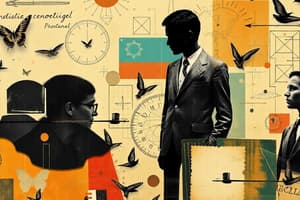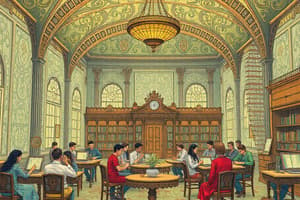Podcast
Questions and Answers
What essential element contributes to 21st-century learning environments by forming a 'people network'?
What essential element contributes to 21st-century learning environments by forming a 'people network'?
- Advanced building infrastructure
- Community of students, educators, and stakeholders (correct)
- Rigid schedules and structured activities
- Comprehensive technology integration
How do flexible learning spaces and extensible technologies primarily contribute to a 21st-century learning environment?
How do flexible learning spaces and extensible technologies primarily contribute to a 21st-century learning environment?
- By reducing the need for educator involvement
- By supporting structured, standardized learning activities
- By minimizing human interaction to foster individual focus
- By promoting human connections and collaboration (correct)
In the context of 21st-century learning, how did John Dewey view schools?
In the context of 21st-century learning, how did John Dewey view schools?
- As hierarchical structures with minimal student input
- As institutions primarily detached from community involvement
- As reflections of the broader society's social relations and activities (correct)
- As isolated entities focused solely on academic instruction
What is a recognized drawback in the structure of schools?
What is a recognized drawback in the structure of schools?
What is the demonstrated effect of positive relationships within an organization like a school?
What is the demonstrated effect of positive relationships within an organization like a school?
What unites all effective school communities?
What unites all effective school communities?
What is primarily facilitated by parental involvement in their children's education, according to Michael Fullan?
What is primarily facilitated by parental involvement in their children's education, according to Michael Fullan?
According to the George Lucas Foundation, what is an outcome of strong home-school connections?
According to the George Lucas Foundation, what is an outcome of strong home-school connections?
Which of the following is fostered within the school organization, stemming from its members' professional values?
Which of the following is fostered within the school organization, stemming from its members' professional values?
What do Professional Learning Communities (PLCs) primarily engage in to foster innovation in 21st-century learning environments?
What do Professional Learning Communities (PLCs) primarily engage in to foster innovation in 21st-century learning environments?
In the context of teacher partnerships, what do cross-generational staffing programs, as recommended by NCTAF, aim to achieve?
In the context of teacher partnerships, what do cross-generational staffing programs, as recommended by NCTAF, aim to achieve?
According to Eleanor Drago-Severson, what is a key role for 21st-century leaders in educational organizations?
According to Eleanor Drago-Severson, what is a key role for 21st-century leaders in educational organizations?
What does an 'outward looking' approach by school leaders primarily involve?
What does an 'outward looking' approach by school leaders primarily involve?
What is the primary benefit of businesses and civic groups coming together with a shared vision for education?
What is the primary benefit of businesses and civic groups coming together with a shared vision for education?
Within the context of education, what does external accountability generally entail?
Within the context of education, what does external accountability generally entail?
What does the South African Schools Act (SASA) of 1996 aim to ensure?
What does the South African Schools Act (SASA) of 1996 aim to ensure?
In South Africa's education system, what did the NCS grades R to 12 replace?
In South Africa's education system, what did the NCS grades R to 12 replace?
What is the main goal of the Education White Paper 6 on Inclusive Education (2001) in South Africa?
What is the main goal of the Education White Paper 6 on Inclusive Education (2001) in South Africa?
What is the intended focus of Screening, Identification, Assessment and Support (SIAS) policy?
What is the intended focus of Screening, Identification, Assessment and Support (SIAS) policy?
What crucial element must policy serve as to guide the development of modern learning environments?
What crucial element must policy serve as to guide the development of modern learning environments?
What is a key emphasis for the citizens of the 21st century in relation to information?
What is a key emphasis for the citizens of the 21st century in relation to information?
What understanding is equally important for policy makers to build on, alongside advances in technologies?
What understanding is equally important for policy makers to build on, alongside advances in technologies?
What must support sophisticated architectures of physical sites and technology infrastructures?
What must support sophisticated architectures of physical sites and technology infrastructures?
Within the context of educational policy, what does it traditionally tend to prioritize?
Within the context of educational policy, what does it traditionally tend to prioritize?
What must educators be given access to support professional and organizational learning, according to the text?
What must educators be given access to support professional and organizational learning, according to the text?
Flashcards
Learning Communities
Learning Communities
Relationships and groups that foster learning and growth.
Isolation to Connection
Isolation to Connection
Moving from isolated learning to interconnectedness among students, educators, and the community.
Learning Community
Learning Community
Groups sharing academic goals and collaborating regularly.
Schools as Miniature Communities
Schools as Miniature Communities
Signup and view all the flashcards
Accountability (External)
Accountability (External)
Signup and view all the flashcards
Accountability (Internal)
Accountability (Internal)
Signup and view all the flashcards
Professional Learning Communities
Professional Learning Communities
Signup and view all the flashcards
Professional Partnerships
Professional Partnerships
Signup and view all the flashcards
Leadership for Learning
Leadership for Learning
Signup and view all the flashcards
Community Partnerships
Community Partnerships
Signup and view all the flashcards
SIAS
SIAS
Signup and view all the flashcards
South African Schools Act (SASA)
South African Schools Act (SASA)
Signup and view all the flashcards
NQ Framework
NQ Framework
Signup and view all the flashcards
Education White Paper 6
Education White Paper 6
Signup and view all the flashcards
Policy
Policy
Signup and view all the flashcards
21st Century Skills (Citizens)
21st Century Skills (Citizens)
Signup and view all the flashcards
21st Century Schools (Environments)
21st Century Schools (Environments)
Signup and view all the flashcards
Policy Support
Policy Support
Signup and view all the flashcards
Study Notes
Communities for Learning
- 21st-century learning is nurtured by certain relationships and communities
- It is important to understand how to create and sustain these relationships and communities
From Isolation to Connection
- Essential for 21st-century learning is a "people network"
- This network includes students, educators, parents, business and civic leaders, and policymakers
- This network represents the human resources of an educational system
Flexible Spaces & Technology
- Flexible spaces and creative uses of time enable productive learning
- Shared work/play opportunities and extensible technologies are important
- These systems are valuable, as long as they support human connections
Learning Community Definition
- A learning community is a group that shares common academic goals and attitudes
- These communities meet regularly to collaborate on classwork
John Dewey's Vision
- John Dewey conceived of schools as "miniature communities" mirroring society
- Schools have often been isolated silos, such as classrooms, teachers, and schools in general
Benefits of Connection
- Positive relationships within and outside an organization help it to fulfill its mission
- Communities can achieve goals impossible through isolated efforts when connected through technology and/or collaborative arrangements
Essential Element of School Communities
- Commitment is needed from every member to learn, including children and adults
Community Support
- 21st-century learning environments both give and get support from families and the local community
- Research shows parental involvement provides important educational advantages
George Lucas Foundation Findings
- Research shows strong home-school connections result in numerous benefits:
- Children perform better in school with parental involvement
- After-school learning promote student achievement
- Youth development programs spur better academic performance
- Integrating community services reduces risk and promotes resilience in children
Accountability: Inside and Out
- Accountability is viewed as a system of external measurement with sanctions for non-performance
- Accountability ensures a school system meets the expectations of external stakeholders
- Internal accountability fosters organizational commitment and innovation
- Internal accountability is fostered within the school and stems from each community member
- Professional values are aligned with personal values to forge a common vision
Professional Learning Communities
- All school members should collaboratively pursue professional knowledge and skills
- They should also take on shared responsibility for student success
- Learning teams engage in reflective practice, collegial inquiry, collaborative work, and innovation
- Schools need to foster new forms of professional relationships
Benefits of Learning Teams
- Educators can refine skills and overcome isolation through supportive learning teams
Professional Partnerships
- Mentoring, coaching, and residencies are 21st-century forms of teacher partnerships
- Partnerships are typically based on the wisdom of apprenticeship
- The National Commission for Teaching and America's Future recommends cross-generational staffing
- Pairing experienced and novice educators can provide support and guidance
Value of Professional Partnerships
- New teachers gain insights from experienced teachers
- Seasoned partners are reenergized by their connection with new teachers
Leadership for Learning
- Educational organizations are growing more diverse and complex
- Good leadership is essential to organize this variety productively
- Key role for 21st century leaders is establishing a culture of shared leadership
Qualities of Successful Leaders
- They establish collegial relationships
- They support constructive change and diversity
- They focus on student learning
- Such leaders provide support for professional communities
- They are "outward looking", seeking ideas and connections outside of the school
- They demonstrate caring for the well-being and development of students and staff
Community Partnerships
- Educational partnerships within the extended community are essential
- Extended partnerships include higher education institutions, the workplace, cultural spheres & civic life
- Schools and higher education work together, but more opportunities exist
- Collaborative work also extends to shared community projects
Benefits of Partnerships
- The greatest benefit comes from positively influencing the future
- Businesses and civic groups come together with a vision for education
- This creates momentum for outcomes for students, parents, schools, and the community
SIAS (Screening, Identification, Assessment and Support)
- Education White Paper 6 on Special Needs Education (2001) outlines how to correct past imbalances
- Inclusive values and practices overcome barriers hindering systems from meeting the range of learning needs
- SIAS (2014) introduced a process for consistent screening, identification, assessment across the education system
South African Schools Act (Sasa), 1996
- Sasa aims to ensure access to quality education and makes schooling compulsory from ages 7-15
- Sasa provides for independent and public schools
- The Act mandates democratic school governance and provides for school-governing bodies (SGBs)
- School-funding norms outlined in Sasa of 1996 prioritize redress
Legislature and other policies
- The National Qualifications Framework (NQF) was refined in October 2007 to comprise 10 levels
- NCS grades R to 12 replaced the policy document, A Résumé of Industrial Programmes in Schools, Report 550 (89/03)
- The Education White Paper on ECD (2000) provides for the expansion of Grade R education by 2010
- The expansion creates better teacher development for birth to four-year-olds and six- to nine-year-olds
- The Education White Paper 6 on Inclusive Education (2001) describes the DBE's goal to implement inclusive education by 2020
- It aims to facilitate the inclusion of vulnerable learners
Policy and 21st Century Environments
- Policy emerges from needs, opportunities, resources, personalities, and political will
- Policy is an organizing structure and promotes 21st-century learning environments
Policy, Guidance, and Objectives
- Policy acts as a guidance system regulating activities, distributing resources, and setting educational priorities within society
- Policies aimed at the same goals reduce conflict
- The first step to creating good educational policy is articulating what education should accomplish
21st Century Citizen Skills
- Citizens need to think critically and creatively
- Citizens must embrace diversity and ambiguity
- Citizens must consume and also create information
- They need to understand the many languages of modernity
- They need fluency in communication, persuasion, presentations, and self-expression
Technology and Human Learning
- Advances in telecommunications and digital technologies enable much learning
- Policy makers need to build on recent gains in the understanding of human learning
- Effective tools must support human growth and development for adults and children
Re-Designing Schools
- Schools must be re-designed to reach beyond traditional classrooms
- 21st century environments encompass virtual and real-life relationships
- They must allow for a mix of media & devices and varied cultures
Policy and Learning Environments
- Policy must serve to create learning environments that are more inclusive
- Organizations need both supports and challenges to thrive and grow
- Educational policy can balance the learning among the adults who care for them
Policy and Educators
- Educators must access knowledge and tools to support professional and organizational learning
- Educators must be offered the time, space, and tools to foster norms of equity and excellence
- Good leadership is also needed
- Opportunities for sharing expertise and best practices are vital within a community
Studying That Suits You
Use AI to generate personalized quizzes and flashcards to suit your learning preferences.




